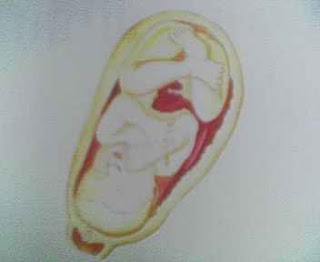
6 Weeks
The beginnings of a backbone and brain are forming. The heart starts to beat. You will be able to hear this if your doctor performs a transvaginal ultrasound examination. You may experience increased pigmentation, engorged breasts, morning sickness, increased urinary frequency and vaginal discharge.
7 Weeks
Four tiny swellings have developed. They are the beginnings of hands and feet. The “tail” gradually disappears into the body (length 5 – 8 mm).
8 Weeks
All the major internal organs are now formed. The embryo has eyes (but no eyelids) and an external ear canal. It starts to make tiny movements but you cannot feel them yet.

The foetus is now about 7 cm long and weighs like an ordinary letter (20g). Finally, he is recognizably human. His head is still very large in proportion to the rest of his body. All his essential organs are functioning though it is still a long way before he can survive independently. At this stage, he is less vulnerable to any interference from say, drugs or virus that may cause malformation.
16 Weeks (4 months)
You uterus is now palpable and is entirely by the baby, placenta and amniotic fluid. Your uterus will stretch gradually as your baby grows. Your baby begins to swallow and pass urine. He has fingernails and toenails. His skin is bright red and transparent. He about 15 cm long (approx 120 g). Your bulge is beginning to show. Your clothes are getting tight. Any sickness you felt earlier will usually be gone by now. There may be some secretion (colostrums) from your nipples.
20 Weeks
your baby’s hair starting to appear and he now has eyebrows and eyelashes. His eyes are still closed. Your baby’s body is covered with a fine, downy hair called lanugo. He is now about 23 cm long (approx 300 g).
Sometime between 18 – 22 weeks, your begin to feel your baby moving as he wriggles about and stretches his arms and legs. This is called “quickening”.
24 WeeksYour baby now measures about 30 cm long (approx 640 g). He has distinct periods of sleep and wakefulness.
You are noticeably pregnant now.
If your baby was bron now, he would have a fair chance of surviving. However, he would have to be put in an incubator because his lungs are still not well-developed.
He is now covered in a thick, white grease called vernix caseosa. This prevents his skin from becoming water-logged
Your baby is now about 35 cm long (approx 1230 g). His kicks are quite strong and can be felt by putting a hand on your tummy.
your baby starts to put on some fat and becomes less wrinkled. His lugs and internal organs are starting to mature. He is about 40 cm long (approx 1700 g).
You may lean back noticeably to counteract your baby’s weight and walk with your legs slightly apart to help your balance.
Usually by now your baby has taken up his final position in the uterus with his head down towards your pelvis.
At about 45 cm long (approx 2300 g), your baby has almost completely filled the uterus.
Your baby has not more room to somersault around but continues to gain weight.
Your may be able to see your tummy moving when your baby moves his limbs. Often you can guess whether the bump is a limb, his head or his body.
40 Weeks
Anytime from 36 weeks onwards, your baby’s head drops down or ‘engages’ into your pelvis, ready for birth.
From 38 weeks, at about 50 cm long (approx 2500 g) your baby is referred to as “full term”. 40 weeks is the average length of pregnancy. It is perfectly normal for your baby to arrive anytime between 38-40 weeks.

















2 komente:
This is a really nice post about development of the fetus. It was nice to see how baby looks like when he is 35 weeks.... Keep it up!
WOW! the pictures look so nice. Make me wish for a 3rd one lol...
You can check this site too for additional info for moms and parenting
http://www.realsavvymoms.com
Posto një koment